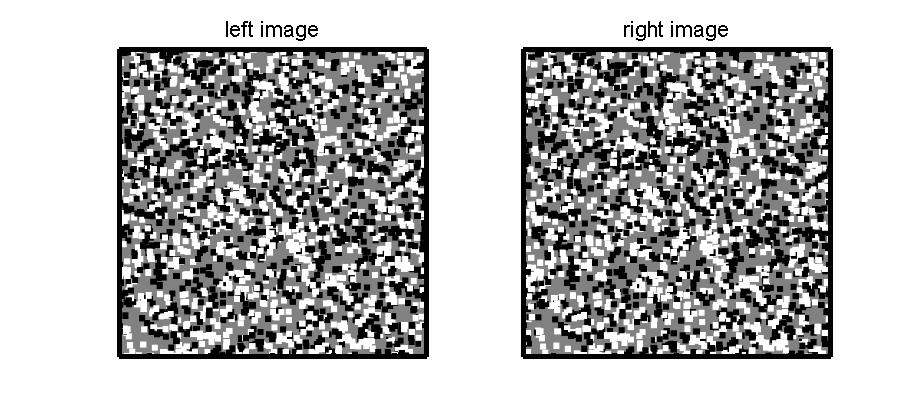

The 'dots' of the stereogram are formed from the pixels in diverse shapes and sizes and are measurably more random in particular respects than dots used in the prior art. The subjects' performances in the control experiment did not show significantly difference between pre-training and post-training sessions. A random dot stereogram is formed using a novel method from relatively fine pixels. Moreover, the training effect was equivalently retained after six months. However, large individual difference existed for fully perceiving the binocular disparity information during perceptual learning session. Participants showed low direction discrimination ability for MID perception of DRDS in the pre-training session, their performance was significantly improved after the perceptual training session. The perception of depth in random-dot stereograms is a purely cyclopean phenom- enon that occurs only when the monocular-eye images are combined to form a. A control experiment involving only pre-training and post-training sessions was carried out to clarify the influence of repeated practice on visual performance improvement. A post-training session was carried out to evaluate the outcome of the training process. Then subjects went through a perceptual training session to improve their sensitivity for the motion detection discrimination. There were three sessions in the main experiment: in the pre-training session, subjects were instructed to discriminate the motion direction of DRDS moving in depth (toward or away from the observer). This study investigated the motion-in-depth (MID) perception in dynamic random dot stereogram (DRDS) among the population of inexperienced normal vision observers, and the role of visual perceptual training for MID perception. The lefteye and right-eye image are arranged identically, except that a portion of the dots is moved to the left or the right in one of the images to create either a crossed or an uncrossed disparity.

Here we fill the window with the pattern.Abstract : Stereopsis is not only the perception of static depth information, but also involves the ability to detect dynamic stereoscopic motion. Random-dot stereograms are stereograms in which the images consist of a randomly arranged set of black and white dots. List_linked_point.append(, ])ĭef display_stereogram(screen, s_width, pattern, p_width, linked_points): In this function we link each pixel in white in the depth map with theĬoordinate of the shifted pixel we will need to create the illusion The dots represent points of an imaginary object that exists behind the paper the stereogram is on.

A stereogram is an image of dots in two colors, usually black and white. I will try to improve this) def get_linked_point(depthmap, d_width, d_height, p_width, sep): Single image random dot stereograms give us a way to view three-dimensional images without using special equipment.
Random dot stereogram code#
To correct this I paired every point of the depth map (not only the white one) in order to come back to the base shifting amount after the end of the star.Ĭode: (This code is the previous one quickly modified after the help of Neil Slater so it's not clean yet. What I didn't get is that because RDS are made by repeated patterns, shifting these pixels also create an opposite shifting with next patterns creating an other star of the opposite depth. What was wrong in my approch is that I only shift pixels that should create the star. Horizontal disparity tuning for dynamic random-dot stereograms was investigated for a large population of neurons (n 787) in V1 of the awake macaque. To create 2 images stereograms you need to shift pixels of one image to make the depth illusion. The problem "I can see on the result 2 objects, 1 star "close" to me and an other star "far" from me" is due to the fact that I get the wrong approach when I try to generalize my understanding of stereograms made with 2 images to stereograms using repeated pattern.


 0 kommentar(er)
0 kommentar(er)
